This post is part of The Caftan Woman Blogathon honoring Patricia Nolan-Hall, hosted by Lady Eve’s Reel Life and Another Old Movie Blog. Read the rest of the posts in tribute of our wonderful friend Paddy HERE!
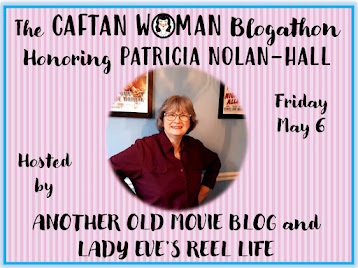
Patricia Nolan-Hall was a film blogger who passed away early March 2022. She was SO beloved by the classic film blogging community. She participated in many blogathons, including many of my blogathons, always commented on blogathon posts, and had a fabulous blog devoted to classic film and television called Caftan Woman. This post and this blogathon are dedicated to Paddy. We miss you so much!
One thing Paddy and I had in common, other than a love of classic film and television in general, is a love for Westerns. Of course I had to pick a Western that Paddy especially loved (and that I love!) to write about.
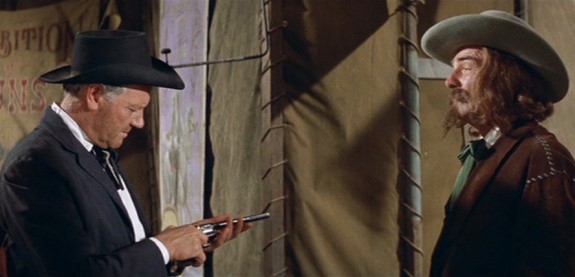
Ride The High Country was director Sam Peckinpah’s second film and is generally considered his first great film. Set in the earlier 20th Century, the Wild West is less wild and old lawmen Steve Judd (Joel McCrea) and Gil Westrum (Randolph Scott) are finding themselves not quite fitting in with the times. Gil runs a carnival booth pretending he is a legendary sharpshooter while wearing a Buffalo Bill-style get-up. He has a sidekick named Heck (Ron Starr) who, as the movie opens, is racing a camel against men on horseback.
Steve wants to enlist Gil and Heck for a job transporting gold from a mining camp. Gil and Heck are reluctant at first but when they find out the value of the gold will be around $250,000 they plan to steal the stash. Gil is confident that Steve will go along with their plan in the end, as he has been down and out for a long time.
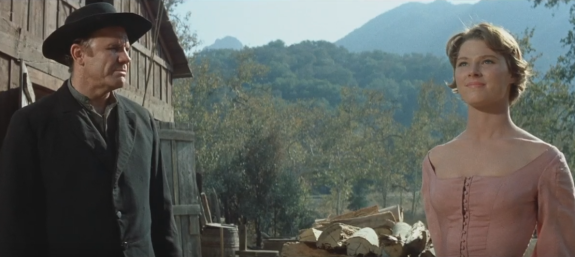
On the way to the camp called Coarsegold, they stop at a farm owned by a Bible-quoting farmer named Knudson (R.G. Armstrong) whose beautiful daughter Elsa (Mariette Hartley) catches the attention of young Heck. Though Elsa tells Heck she is engaged to a miner in Coarsegold named Billy Hammond (James Drury) she still meets him in the moonlight. Her father is furious and slaps her.
While on the trail again to Coarsegold, Elsa catches up to them, telling them she wants to go with them so she can marry her fiancée. They reluctantly let her join them.
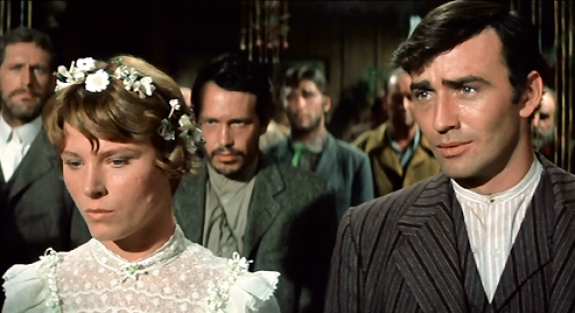
Elsa is reunited with Billy at the mining camp but is disturbed by his four coarse and leering brothers. She still goes through with the marriage which takes place at the camp’s brothel. When it’s clear Billy means to let his brothers share Elsa’s favors, Steve, Gil, and Heck rescue her by forcing the judge who performed the marriage to pretend he is not authorized to do so.
Now with the gold in hand, Gil realizes that Steve will not go along with the plan to rob the gold, as all he wants is to regain some of the self-respect he had when he was a lawman. While trying to sneak off with the gold Gil and Heck are apprehended by Steve who is bitterly disappointed in his friend’s betrayal. Heck is ashamed of his actions and accepts that he is caught. Gil refuses to fight Steve when he offers to let him draw on him.
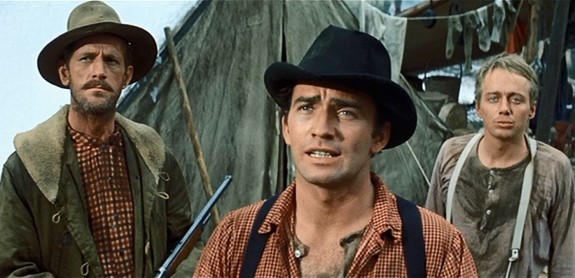
The Hammond brothers catch up with them and there is a shoot-out, with two of the brothers ending up dead. At night, Gil finds the horse and gun of one of the dead brothers and escapes, but still follows the same trail as the others.
At the farm, they realize Elsa’s father has been shot and have another gunfight with the surviving Hammonds. Gil joins in the fight to help his old friend, who is mortally wounded. They defeat the Hammonds. Gil promises he will complete the transportation of the gold just as Steve would have done. Steve asks to be left alone so the two young people don’t have to watch him die.

There are several reasons why Ride the High Country is a favorite of mine. The first is the spectacular cinematography by Lucien Ballard. This is one of the most beautiful color Westerns ever made (hey, hey, John Ford fans, his are beautiful, too, don’t come at me). Shot in California, partly in Inyo National Forest, it is simply breathtaking to look at.
Another is the stellar cast headed by two lions of classic Western films, McCrea and Scott. This was Scott’s final film (it was supposed to be McCrea’s, but he came out of retirement to do more films later on). Peckinpah used their iconic presence to full effect here, aging men at the end their careers playing aging men at the age of their careers. Originally, Scott was going to play Steve and McCrea was going to play Gil, but both agreed they were better suited for the other’s role. Peckinpah flipped a coin to see who would get top billing (Scott won) but in the end they were billed together.
Peckinpah had a strong handprint on the final screenplay (credited to N.B. Stone Jr.) and flipped some of the usual genre tropes. Originally, it was Gil who was supposed to die in the end, the “black hat” dying somewhat redeemed. Instead, Steve, “the white hat” is the one who dies, satisfied he has regained his self-respect and knowing perhaps has even helped his erstwhile friend find his.

The film introduced actress Mariette Hartley, who has a more substantial role for a woman than you usually find in a Peckinpah film. Desperate to escape an abusive father (and, it’s suggested, one with an incestuous interest in her) she makes the mistake of her life marrying into the Hammond family. Drury, who is best known from the television series The Virginian, here is handsome but vile man who sees Elsa as much of a possession as her father ever had. Heck is introduced as a horn dog (Steve and Gil have to literally drag him off Elsa at one point; a foreshadowing of her reunion with Billy) but over the course of the story becomes a better man under the influence of Steve and his determination to “enter his house justified.”
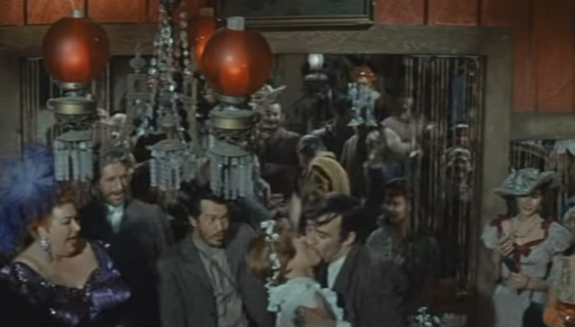
In spite of the two spectacularly shot gunfights and the chaotic wedding sequence bubbling with violence, this film may surprise fans of Peckinpah’s later work. This is a more introspective film. It didn’t try to blow up the genre like some late revisionist Westerns. Instead, it dissected it by peeling away the skin of the iconic characters.
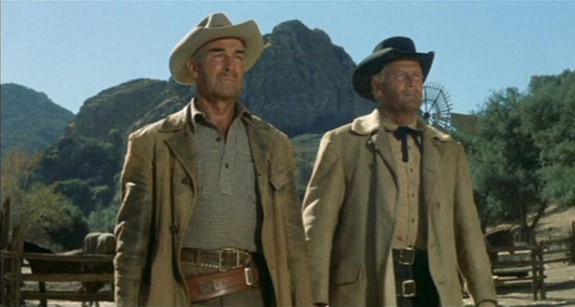
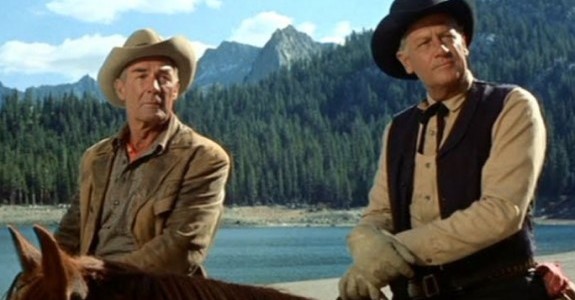
Terrific choice in honor of Paddy. I adore this movie too so your take was particularly enjoyable.
What a difference Paddy made in our our blogging lives. It’s amazing. Thank you.
Aurora
So true. Definitely feels like a gap exists now. I know I will always miss her. Thank you!
Boy did Paddy love her westerns! I’m not normally one who is attracted to them, but then find that I like them after I’ve seen them. Go figure. This is a lovely post and I am sure she would have had an encouraging and insightful comment to add. Hopefully, this will suffice in her much missed absence.
Thank you so much for co-hosting this blogathon! Not only for the opportunity to share my thoughts on a great movie that Paddy and I both loved, but also the opportunity to honor her. ❤️❤️❤️
During 2020, when I had no new movies to blog about, I devoted a month to westerns, and I made sure to include a Randolph Scott movie, specifically because of Paddy. Growing up, westerns were the movies my parents watched, and therefore, they were uncool. As a film blogger, over time, that changed. Years earlier, she wrote about RIDE THE HIGH COUNTRY for one of our three blogathons together and that led me to write about it too. Good film.
It’s funny, I started watching Westerns (and noirs) because my dad liked them. We didn’t like a lot of the same things but movies were the one thing we both loved. I’m glad you came around to appreciating them! 😁
It always amazed me what a broad scope of interests Paddy had. From Charlie Chan to Ford westerns and everything in between and beyond. I’m not the biggest western fan, though there are several primarily from Ford) that I love, and Ride the High Country is one of them. Bottom line, for me, is McCrea and Scott at the perfect moment in their careers with the right material and a promising director coming into his own. Really enjoyed this tribute for so many reasons. Great choice, great piece.
Thank you! And thanks for hosting this tribute to Paddy, it’s been lovely reading everyone’s thoughts about how she impacted our community.
I like that so many people have chosen westerns (along with other genres, of course) for this blogathon. Paddy would love it. 🙂
Me too! People assume women don’t care for Westerns but Paddy and I prove them wrong. 🙂
Woo hoo!
I greatly enjoyed your write-up on one of my favorite westerns, and one of the few that I’ve seen more than once. And knowing how Paddy loved her westerns, I’m glad to see this one covered. I appreciate learning more about the film, including that Scott’s character was originally slated to be the one to die, and that Sam Peckinpah flipped a coin to decide the billing. Great stuff.
Thank you! I always love finding out the story behind the films we love and this is a really good one.
When I first began watching movies – seeing them mostly on TV accompanied by a string of commercials every 20 minutes (later, TCM was a blissful exception) – I had no interest in cowboy movies. Only boys liked westerns, and I was a girl. A friend loaned me his favorite movie, Ride The High Country, and I loved it. 2 major stars from Hollywood’s Golden Era, now ‘old’, but still wildly attractive, played the leads. 2 old friends riding together on their last hurrah. When McCrea was shot dead at the end – I was shocked! and cried buckets. This movie changed by attitude about westerns. Now the door was open and in rode John Wayne in his wonderful late-40s ‘Cavalry Trilogy’ westerns made with John Ford. Thanks to Peckinpah and Paddy too.
So happy to hear how many people appreciate this movie. Yes, McCrea and Scott were definitely silver foxes when they made this movie. 😉
Paddy certainly loved her Westerns and she Ride the High Country was one of her favourites. I love it too. After years of seeing him on The Virginian, I was surprised but delighted to see James Drury playing a not-so-nice guy! Anyway, you did a great write-up on Ride the High County. I know Paddy must appreciate it.
I was SHOCKED the first time I realized Drury was the same guy who played The Virginian. I always say a big part of a movie’s success is casting. Peckinpah knew what he was doing here with just about every role.
Can’t believe I still haven’t seen this one, but it does look like a film Paddy would’ve liked. I really enjoyed your tribute to her and to this film.
I hope you get a chance to view it. Some people are put off because it’s Peckinpah and they think he’s not their cup of tea, but this movie appeals to many beyond his fandom.
Adding this one to the must see list! Thank you for highlighting in Paddy’s honor. She would have loved your tribute.
Thank you! Hope you see it and that you love it!
A perfect choice to honor Paddy. I learned so much about Westerns from her that it has become a favorite genre. Ride the High Country has one of the most memorable endings in all of film too. I love it and your terrific commentary.
Aurora
Thank you! It was an honor to write this in tribute to Paddy. So moved by the responses and the other posts contributed to the blogathon.
Between the two of us, we have a Sam Peckinpah Trilogy going. When Paddy Lee passed away, I was working on The Wild Bunch, which was dedicated to her. For her tribute event, you did this film. And for your Foreign Western blog-a-thon in a few weeks, I’m dong Bring Me The Head of Alfredo Garcia.
In advance of your blog-a-thon, I’ve done something that sports team do when they lose a legend. On the main logo on Dubsism, there is now a small black patch with the initial “CW” for Caftan Woman.
What a wonderful idea! So looking forward to reading your post about Bring Me the Head of Alfredo Garcia. The only thing I know about it is that it was in that mostly debunked book The 50 Worst Movies of All Time.
The problem BMTHOAG has it it’s easy to not get it. If you don’t get it, you’ll hate it. A lot of that comes from the fact it doesn’t fit neatly into any single “box.” But there are many who consider it to be Peckinpah’s masterpiece.